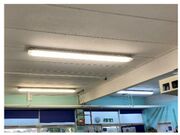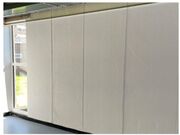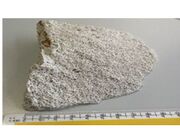Reinforced autoclaved aerated concrete
Description
A lightweight, ‘bubbly’ form of concrete masonry blocks and pre-cast panels commonly used in construction between the 1950s and mid-1990s. Autoclaved Aerated Concrete (AAC) was made using a fine aggregate mixed with chemicals to create gas bubbles then cast with a metal reinforcement (RAAC) network and cured with high heat. The result was a relatively weak concrete that had poor load-bearing ability and weak bonding with its embedded metal reinforcement. RAAC pre-cast panels were predominantly used in roofs (commonly flat roofs, sometimes pitched) and occasionally in floors and walls. The panels are light-grey or white in appearance, with a smooth, paintable surface. The inside of the planks will appear bubbly, often described as looking like an Aero bar. Unlike traditional concrete, there will not be visible stones (coarse aggregate) in the panels. The panels have distinctive V-shaped grooves at at the connection points (every 600 mm). A bituminous or latex coating was sometimes added as a water barrier.
Synonyms and Related Terms
RAAC; Reinforced AAC
Risks
- Cracking and spalling
- Load-bearing failure
- Corrosion of metal reinforcements
- Movement and deflections of panels
Forms and Sizes
- Typically 600 mm wide panels
Resources and Citations
- Conservation Distlist: RAAC concrete thread Accessed August 2023
- Department of Education (UK): RAAC: Government Identification guide
- Structural-Safety: Failure of RAAC
- Wikipedia: Reinforced Autoclaved Aerated Concrete Accessed August 2023


